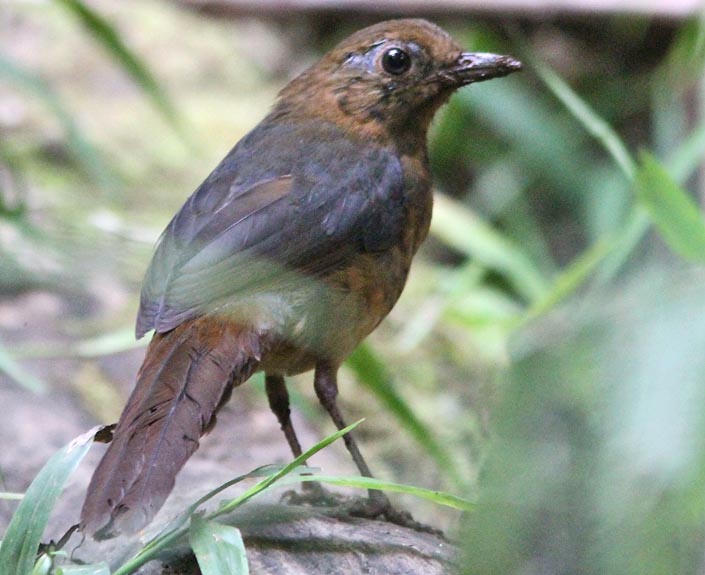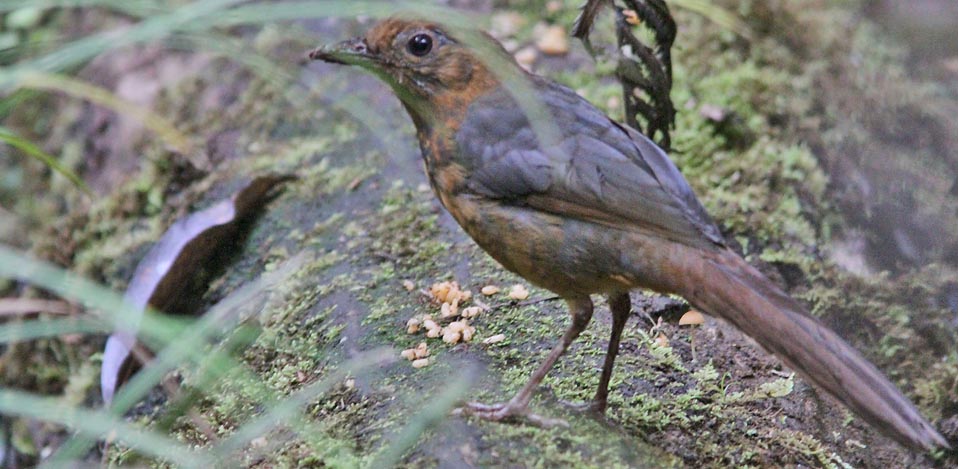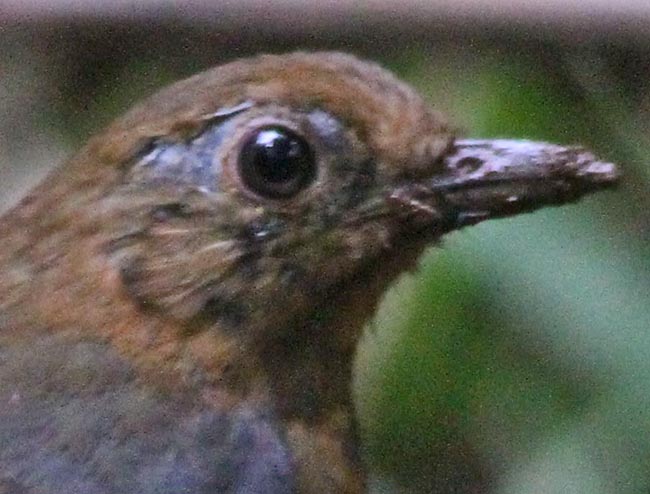
a web page by Don Roberson |
GEOMALIA Geomalia heinrichi |
||
|
||
 Geomalia
is an enigmatic, ground-dwelling bird of montane Sulawesi, Indonesia.
There are, as yet, no molecular studies to place this bird within any
family. It has some features similar to thrushes and others similar to
babblers. Most recent world checklists — Clements (2011), IOC (2011),
HBW (2005), Howard & Moore (2003), Sibley & Monroe (1990) —put
it, tentatively, with the thrushes (Turdidae). Geomalia
(left and below) does superficially look like a large thrush. Yet some
features not thrush-like: it has no known song; its locomotion include
running and hopping; there is extensive bare skin around the eye
(giving almost a 'ground-cuckoo' feeling); and has an atypical tail for
a thrush, which is long, graduated, and round-tipped. The latter gives
Geomalia an un-thrush-like shape, recalling something more ancient,
like Rail-babbler Eupetes macrocerus. Geomalia
is an enigmatic, ground-dwelling bird of montane Sulawesi, Indonesia.
There are, as yet, no molecular studies to place this bird within any
family. It has some features similar to thrushes and others similar to
babblers. Most recent world checklists — Clements (2011), IOC (2011),
HBW (2005), Howard & Moore (2003), Sibley & Monroe (1990) —put
it, tentatively, with the thrushes (Turdidae). Geomalia
(left and below) does superficially look like a large thrush. Yet some
features not thrush-like: it has no known song; its locomotion include
running and hopping; there is extensive bare skin around the eye
(giving almost a 'ground-cuckoo' feeling); and has an atypical tail for
a thrush, which is long, graduated, and round-tipped. The latter gives
Geomalia an un-thrush-like shape, recalling something more ancient,
like Rail-babbler Eupetes macrocerus. |
||
 |
||
Collar (2005) summarizes the argument for considering this species a thrush as having "certain turdine features, including lightly spotted underparts in juvenile plumage, rather confident terrestrial foraging behavior and thrush-like posture" but, alternatively, "other features (very short, rounded wing, pale wingpanel, fully elongate feathers on side of rump and round thighs, and long rounded tail) all tend to suggest affinities with the timalid genus Garrulax (among the laughing-thrushes). Collar also notes that the status of Sulawesi Thrush Cataponera turdoides is likewise uncertain, and has not been the subject of molecular research, and concludes that "there is deep uncertainty about these extraordinary animals, which exhibit both turdine and timaliine characters, giving rise to the notion that they may be a primitive relations of both families. Both Sulawesi Thrush (below left) and Geomalia (below right) occur in Lore Lindu NP, Sulawesi, and we saw several Sulawesi Thrushes and three Geomalia during a September 2011 visit [the Geomalia below right is a different individual than the one above]. Sulawesi Thrush was very "thrush-like" in my view, in size, stance, and behavior. They fed around mud puddles on a dirt road at dawn but spent much of the day high in the canopy, working along large limbs (as shown below left). The bright yellow-orange bill looked very "thrush-like." In contrast, Geomalia was only on the ground or on fallen logs, and did not seem closely related to Sulawesi Thrush in size, posture, or some of its behaviors (like running along logs). Further, Sulawesi Thrush has a known song; there is no known song for Geomalia. |
||
|
||
Clement (2000) considered Sulawesi Thrush to be very like Turdus thrushes, and not remotely related to Geomalia (and I agree). Clement (2000) discussed the taxonomic history of Geomalia in some detail. Stresemann (1931), who first described Geomalia (in German literature), thought it a babbler, but placed it in its own genus, since it appeared to have no close babbler relatives. The name "Geomalia" referenced another Sulawesi endemic, the apparently unrelated Malia Malia grata, a mysterious arboreal species in the same montane forests, and means "ground malia." It was Ripley (1952) who moved the genus to thrushes. White & Bruce (1986), followed by Coates & Bishop (1997), disagreed. They were not comfortable in calling Geomalia a thrush, but proposed that further study was needed to determine its taxonomic position. It may be an ancient relict with no modern relations. There the matter stands today. According to White & Bruce (1986), Heinrich, who discovered Geomalia, never heard any song for it. Heinrich collected young birds but Streseman made no mention of a thrush-like juvenal plumage (as he had done for Cataponera, the Sulawesi Thrush). Coates & Bishop (1997) described a thin, high-pitched, dry whistle of up to a second in length. This description of the Geomalia vocalization has been republished by Clement (2000) and Collar (2005). However, Rob Hutchinson, who regularly visits Lore Lindu leading tours for a number of years, and for whom Geomalia is a major target of the trip, has never heard Geomalia give any vocalization (pers. comm). Vocalizations thus also remain mysterious, and Geomalia's song is unknown. |
||
Two weakly defined races are reported from montane Sulawesi, where it occurs in the mountains of the southeast and south-central portions of the island. Its usual range is given as between 1700–2800m. On our 2011 visit, we saw a pair at 1645m (~5400 ft), in the forest right near Lake Tambing (i.e., the one shown to the left and the same bird top of the page was one of this pair), which is a very low elevation for Geomalia. Our other bird, foraging on the Anaso track, was at about 2200m (~7200 ft), which is considered to be a more typical elevation for this interesting species. It seems quite odd to me that the substantial amount of bare skin around the eye, apparent on both sides of the head of the Geomalia photographed at close range, does not seemed to be mentioned in the literature. Obviously it will take genetic evidence to determine whether Geomalia should be placed in the thrushes, or the babblers, or elsewhere, or even, perhaps, in its own family. |
||
Photos: The Geomalia Geomalia heinrichi and Sulawesi Thrush Cataponera turdoides were in Lore Lindu NP, Sulawesi, Indonesia, in Sep 2011. Photos © Don Roberson; all rights reserved. Literature cited:
|


 It
seems apparent from the mud on its bill (left) that Geomalia spends
much time foraging with on the damp forest floor. Collar (2000) wrote:
"Extremely shy and secretive, frequently overlooked; usually alone,
even during the breeding season, rarely seen in pairs. Inhabits the
forest floor where it walks, or hops with wings held low and horzontal
with the back, over vegetation, often flicking or twitching its tail in
an agitated fashion. Has very short rounded wings and flies weakly,
generally over very short distances. Forages on the ground amonst
rotting and decayiing vegetation for beetles and their larvae, probably
takes other insects." Collar (2005) describes published stomach
contents as being beetles and their larvae, and a small snail.
It
seems apparent from the mud on its bill (left) that Geomalia spends
much time foraging with on the damp forest floor. Collar (2000) wrote:
"Extremely shy and secretive, frequently overlooked; usually alone,
even during the breeding season, rarely seen in pairs. Inhabits the
forest floor where it walks, or hops with wings held low and horzontal
with the back, over vegetation, often flicking or twitching its tail in
an agitated fashion. Has very short rounded wings and flies weakly,
generally over very short distances. Forages on the ground amonst
rotting and decayiing vegetation for beetles and their larvae, probably
takes other insects." Collar (2005) describes published stomach
contents as being beetles and their larvae, and a small snail.